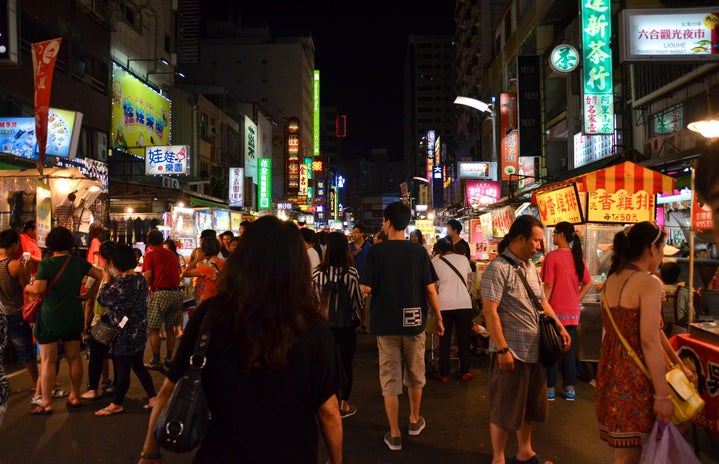Techno-Orientalism. Technology and Orientalism. These two concepts make sense on their own, but when put together, one begins to wonder how these two seemingly different topics could intersect or converge. I had that same thought when I first came across this term when reading an academic paper for my Introduction to Asian American Cultural Studies course (ASA 4). Upon learning more about “techno-Orientalism” in lecture, I was shocked by how I saw instances of this concept everywhere in the various media I have consumed and never questioned why this recurring idea was so normalized.
You’ve probably seen it in all sorts of cyberpunk or science-fiction media: the Asian iconography and influences in the neon-lit futuristic cities of such movies as Blade Runner 2049 and Ghost in the Shell, or even in video games such as Stray and Cyberpunk 2077. It’s almost uncanny how often we associate imagery of Asian culture with ideas of advanced technology (namely AI), cities, or robots in popular mainstream media.
The inextricable linking of Asian aesthetics to the science fiction genre, particularly that of the cyberpunk sub-genre, is an evidently common trope that remains unquestioned. But why should we start questioning its prevalence in media? And why does this concept matter in the larger context of society and public discourse?
To begin, let’s first briefly unpack what Orientalism is:
Orientalism is a term coined by literary theorist Edward Said that “refers to the construction of the Orient by European colonial powers in the 19th Century and onward” and is generally known to be a field of study about Asian culture and societies. It’s important to reiterate that orientalism hinges on the fact that the West has created a largely inaccurate and un-nuanced view of the East through second-hand accounts and an ethnocentric perspective in the context of Western colonialism, resulting in the creation of an imagined Orient over which they can establish their authority. Orientalism has mainly been used by the West as a means to establish its superiority and dominance over the Orient (the East) by way of vehemently differentiating between the two and portraying “the Orient…as a threatening, inferior, and underdeveloped ‘Other.’” By depicting the East as backward and incapable, the West can justify its authority and superiority over its imagined Orient and the subsequent Othering of the East that follows.

With this in mind, what is Techno-Orientalism?
Techno-Orientalism is defined as “the phenomenon of imagining Asia and Asians in hypo-or hypertechnological terms in cultural productions and political discourse” and “imaginations” of this are often “infused with the languages and codes of the technological and the futuristic.” Techno-Orientalism differs from Orientalism, in that instead of viewing the East as backward, they are now associated with advancement and hyper-productivity, which may seem like a more flattering and positive depiction. However, in the context of Orientalism where the East is always held in the position of an “Other” to the West, “the lens of techno-Orientalism” now regards “Asian” as “synonymous with ‘the image of a culture that is cold, impersonal and machine-like, an authoritarian culture lacking emotional connection to the rest of the world.’”
This imagined shift of the East to a future that is dominated by unfeeling corporations and Asian bodies that are likened to emotionless robots or sub-human beings is another method of the West to control its power and define its authority position over the East as a response to the “cultural emasculation” they felt in the face of Asian technological advancements. Additionally, techno-Orientalism was also used to stoke fears of a potential future where these machine-like Asian corporations are in power; thus justifying their dominance in world affairs by painting themselves as the better alternative to this imagined future.
Why does this matter?
Techno-Orientalism often manifests itself in popular science fiction works and the cyberpunk genre, drawing inspiration from Asian cities to craft fictional dystopian worlds often inhabited by cyborgs or AI robots that are portrayed in the likeness of Asian bodies. This trope of linking Asian aesthetics to media that illustrates a futuristic world populated by unfeeling Asian-coded cyborgs is by and large problematic as it serves to further objectify Asian bodies and also implicitly add credence to the depiction of an essentialized East that is ultimately not full-bodied and accurate. There’s also an undercurrent of xenophobia in such depictions of Asia and Asian bodies as something machine-like and lacking all aspects of humanity to exacerbate Western fears or disgust of interacting with or possibly being dominated by them in the context of techno-orientalism. It’s important to critically evaluate and analyze the use of such techno-orientalist tropes in the media we consume to not fall victim to normalizing these xenophobic and problematic ideas that we are subconsciously fed.
I hope you learned something new from reading this and begin to look at works that utilize techno-Orientalist tropes with a more critical lens.




